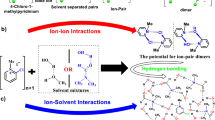Abstract
Purpose. This work examines the lipophilic behavior of various zwitterions and shows how distribution profiles in biphasic systems and ionic partition diagrams may improve our understanding of pH-absorption profiles of drugs.
Methods. The lipophilicity of various zwitterionic drugs was examined by potentiometry and cyclic voltammetry in the 1,2-dichloroethane/water system to study the intramolecular interactions and conformational effects affecting absorption and activity of zwitterions, as well as to draw their theoretical and experimental ionic partition diagrams.
Results. Different theoretical partition diagrams are reported according to the tautomeric constant of the zwitterion. Shifts of apparent pKa are obtained in the ionic partition diagrams of raclopride and eticlopride and compared to the deviations from pH-absorption profile described in the literature for lipophilic drugs. The physicochemical origin of these shifts is discussed.
Conclusions. The comparison between pH-absorption profiles and ionic partition diagrams of zwitterions is shown here to be of value for a better mechanistic understanding of absorption processes, thus opening new perspectives in studying pH-absorption profiles of ionizable drugs.
Similar content being viewed by others
REFERENCES
A. Pagliara, P.-A. Carrupt, G. Caron, P. Gaillard, and B. Testa. Lipophilicity profiles of ampholytes. Chem. Rev. 97:3385–3400 (1997).
G. Caron, F. Reymond, P.-A. Carrupt, H. H. Girault, and B. Testa. Combined molecular lipophilicity descriptors and their role in understanding intramolecular effects. Pharm. Sci. Technol. Today 2:327–335 (1999).
G. Bouchard, A. Pagliara, G. Plemper van Balen, P.-A. Carrupt, B. Testa, V. Gobry, H. H. Girault, G. Caron, G. Ermondi, and R. Fruttero. Ionic partition diagram of the zwitterionic antihistamine cetirizine. Helv. Chim. Acta 84:375–387 (2000).
A. Albert and E. P. Serjeant. The Determination of Ionization Constants. A Laboratory Manual. Chapman and Hall, London, 1984.
J. Wang and R. J. Boyd. Tautomeric equilibria of hydroxypyridines in different solvents: an ab initio study. J. Phys. Chem. 100:16141–16146 (1996).
K. Takács-Novák and K. Y. Tam. Multiwavelength spectrophotometric determination of acid dissociation constants-Part V: Microconstants and tautomeric ratios of diprotic amphoteric drugs. J. Pharm. Biomed. Anal. 21:1171–1182 (2000).
R. S. Tsai, P.-A. Carrupt, B. Testa, P. Gaillard, N. El Tayar, and T. Hoegberg. Effects of solvation on the ionization and conformation of raclopride and other antidopaminergic 6-methoxysalicylamides: insight into the pharmacophore. J. Med. Chem. 36:196–204 (1993).
R. Bonaccorsi, P. Palla, and J. Tomasi. Conformational energy of glycine in aqueous solutions and relative stability of the zwitterionic and neutral forms. An ab initio study. J. Am. Chem. Soc. 106:1945–1950 (1984).
F. R. Tortonda, J. L. Pascual-Ahuir, E. Silla, and I. Tunon. Why is glycine a zwitterion in aqueous solution? A theoretical study of solvent stabilizing factors. Chem. Phys. Lett. 260:21–26 (1996).
N. E. Hal and B. J. Smith. Solvation effects on zwitterion formation. J. Phys. Chem. A 102:3985–3990 (1998).
F. Reymond, G. Steyaert, P.-A. Carrupt, B. Testa, and H. H. Girault. Ionic partition diagrams: a potential-pH representation. J. Am. Chem. Soc. 118:11951–11957 (1996).
1,2-Dichloroethane (Environmental Health Criteria N° 176). World Health Organization, Geneva, 1995.
V. Gobry, G. Bouchard, P.-A. Carrupt, B. Testa, and H. H. Girault. Physicochemical characterization of sildenafil: ionization, lipophilicity behavior, and ionic-partition diagram studied by two-phase titration and electrochemistry. Helv. Chim. Acta 83:1465–1474 (2000).
K. Takács-Novák, J. Kökösi, B. Podanyi, B. Noszal, R. S. Tsai, G. Lisa, P.-A. Carrupt, and B. Testa. Microscopic protonation/deprotonation equilibria of the anti-inflammatory agent piroxicam. Helv. Chim. Acta 78:553–562 (1995).
CLIP1.0. Institute of Medicinal Chemistry, University of Lausanne, 1996.
P.-A. Carrupt, P. Gaillard, F. Billois, P. Weber, B. Testa, C. Meyer, and S. Pérez. The molecular lipophilicity potential (MLP): a new tool for log P calculations and docking, and in comparative molecular field analysis (CoMFA). In V. Pliska, B. Testa, and H. van de Waterbeemd (eds.), Lipophilicity in Drug Action and Toxicology, Vol. VCH Publishers, Weinheim, 1996, pp. 195–217.
G. Caron, A. Pagliara, P.-A. Carrupt, P. Gaillard, and B. Testa. Physicochemical properties of the anti-inflammatory drug azapropazone. Helv. Chim. Acta 79:1683–1685 (1996).
A. Pagliara, B. Testa, P.-A. Carrupt, P. Jolliet, C. Morin, D. Morin, S. Urien, J. P. Tillement, and J. P. Rihoux. Molecular structure and pharmacokinetic behavior of cetirizine, a zwitterionic antihistamine. J. Med. Chem. 41:853–863 (1998).
E. H. Gold, W. Chang, M. Cohen, T. Baum, S. Ehrreich, G. Johnson, N. Prioli, and E. J. Sybertz. Synthesis and comparison of some cardiovascular properties of the stereoisomers of labetalol. J. Med. Chem. 25:1363–1370 (1982).
G. Steyaert, G. Lisa, P. Gaillard, G. Boss, F. Reymond, H. H. Girault, P.-A. Carrupt, and B. Testa. Intermolecular forces expressed in 1,2-dichloroethane/water partition coefficient: a solvatochromic analysis. J. Chem. Soc. Faraday Trans. 93:401–406 (1997).
D. A. Y. L. I. G. H. T. Software. 4.41. Daylight Chemical Information System, Inc., Irvine, California, 1995.
F. Reymond, P.-A. Carrupt, B. Testa, and H. H. Girault. Charge and delocalisation effects on the lipophilicity of protonable drugs. Chem. Eur. J. 5:39–47 (1999).
R. S. Tsai, P.-A. Carrupt, N. El Tayar, B. Testa, Y. Giroud, P. Andrade, F. Brée, and J. P. Tillement. Physicochemical and structural properties of non-steroidal antiinflammatory oxicams. Helv. Chim. Acta 76:842–854 (1993).
A. Tsuji, E. Miyamoto, N. Hashimoto, and T. Yamana. GI absorption of β-lactam antibiotics II: deviation from pH-partitioning hypothesis in penicillin absorption through in situ and in vitro lipoidal barriers. J. Pharm. Sci. 67:1705–1711 (1978).
L. S. Schanker. On the mechanism of absorption of drugs from the gastrointestinal tract. J. Med. Pharmac. Chem. 2:343–359 (1960).
D. Winne. Shifts of pH-absorption curves. J. Pharmacokin. Biopharm. 5:53–94 (1977).
D. Winne. Deviations of intestinal drug absorption from the pH-partition theory. Acta Pharm. Technol. 33:53–59 (1987).
H. Kubinyi. QSAR: Hansch Analysis and Related Approaches. VCH Publishers, Weinheim, 1993.
V. Gobry, S. Ulmeanu, F. Reymond, G. Bouchard, P.-A. Carrupt, B. Testa, and H. H. Girault. Generalisation of ionic partition diagrams to lipophilic compounds and to biphasic systems with variable volume ratio. J. Am. Chem. Soc. 123:10684–10690 (2001).
Rights and permissions
About this article
Cite this article
Bouchard, G., Pagliara, A., Carrupt, PA. et al. Theoretical and Experimental Exploration of the Lipophilicity of Zwitterionic Drugs in the 1,2-Dichloroethane/Water System. Pharm Res 19, 1150–1159 (2002). https://doi.org/10.1023/A:1019846125723
Issue Date:
DOI: https://doi.org/10.1023/A:1019846125723




